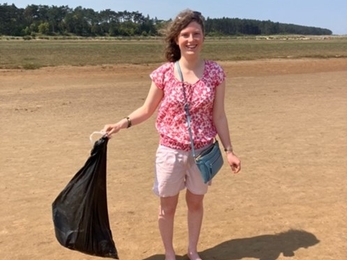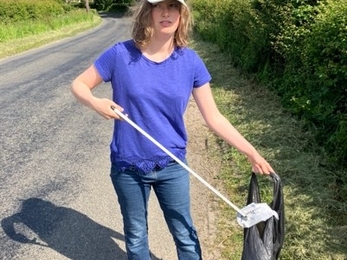“'Random acts of wildness' can take as little or as long as you would like - even ten minutes outdoors helps. It’s a brilliant way to get to know your local area, and to discover the wildlife on your doorstep”.
Youth Board update – 30 Days Wild
Youth Board - Simply C Photography
For the first week of 30 Days wild, Megan, Lydia and Henry moved in nature by going on an invertebrate hunt
Megan:
I've been for a bug hunt in the woods today, and these two gorgeous insects were definitely the highlight! I found an emperor dragonfly resting by a stream, and also managed to catch a male banded demoiselle, as seen in the video.
I think 30 Days Wild is a brilliant way to get to know your local area, and to discover the wildlife on your doorstep. 'Random acts of wildness' can take as little or as long as you would like - even ten minutes outdoors helps. They're also great for a bit of relaxation in the middle of a busy week (running around outdoors with my net has been the best distraction from uni exams!)
Lydia:
While I was having a barbecue on a sunny day, I spotted a beetle on the table. Later, I found out that it was a type of green weevil called phyllobius maculicornis. This shows nature is all around us, and even stepping into our back gardens, can be a wild thing to do. Taking part in the 30 days wild challenge, doesn't need to be difficult, and we can learn so much if we take the time to look.
Henry:
Last summer, I put up a bee hotel on my playhouse in the garden. I was a bit disappointed when nothing used it, until a friend suggested that I move it out of the shade and into a sunny spot. Last week I went to check on it and couldn’t believe my eyes – bees were coming and going, busily filling up the chambers whilst I stood and watched them. I also made another bee hotel out of some old shelves and filled it with bamboo and deadwood which I drilled holes into to make the chambers.
I had a look in one of my insect books and identified them as Red Mason Bees. The female lays an egg at the end of the chamber, deposits pollen and nectar for when the larvae develops next spring and then seals the section off with mud. She then goes through this process again and again until the chamber is full.
My mum put a post on Facebook about my bee hotel to encourage people to help the bees by putting one up in their garden. I received some lovely comments from all over the world (even as far as New Zealand!) from people either relocating their hotels as I suggested, or buying or even making their own! My post received an incredible 63.2k likes, 2.2k comments and 1.3k shares! I was absolutely thrilled that I had managed to reach so many people that wanted to help the bees too and that bee hotels would be going up in gardens all over the world!
In week 2, James, Evie and Irene discovered nature by learning more about the wildflowers growing on their walks to school and work.
James:
I have found it really fun finding and remembering the places of interesting wildflowers and potentially planted ones that grow on my way to school. Native is best. There are also many incredible trees.
I think people should join 30 days wild as it can bring your maybe quite hidden passion for nature to account, as you fill in the online calendar and do the activities. Doing these ‘random acts of wildness’ connect you to nature more, with your family or friends, and can inspire you to be more involved in protecting it. It also is genuinely good for your health, taking in nature. The solace and the escape. Let's take it all in as a community in 30dayswild.
Check out James' video, where he shares tips on identifying wildflowers, on our Instagram and Facebook!
Evie:
I discovered this beautiful bank of oxeye daisies on my way to school.
Did you know oxeye daisies are also known as dog daisies, horse daisies, moon daises or moonpennies? Moon daises or moonpennies seems appropriate because these bright flowers appear to glow in amongst the grass on summer evenings.
Research shows that taking time to notice nature every day makes us happier and healthier and because we feel more connected to nature, we are more likely to care for it. What wild flowers can you spot on your way to school, college or work? Could you leave the grass to grow long in your garden? You never know, you might see some moon daisies of your own!
Irene:
Flower power! Spotted and sniffed a sweet-smelling dog rose on my way to work. I love taking in the beautiful wildlife this time of year on my commute! We need wildflowers and thick hedgerows in full bloom to help our hedgehogs, pollinators and nesting birds.
In week 3 Hannah and Molly helped nature by going on a litter pick
Hannah:
I have been doing a litter pick across East Anglia for 30 days wild and I sincerely hope that after reading this you will want to do the same. I promise it will make you feel good and proud to know you’ve made a difference to your local surroundings whilst connecting to nature.
Rubbish has a huge detrimental impact on marine wildlife. Approximately 8 million tonnes of plastic litter find its way into the oceans. Plastic is one of the biggest threats to marine wildlife as it breaks down into small pieces and does not disappear overnight.
Litter picking helps to create a better space for wildlife and humans, it improves the cleanliness of your surrounding area. It gets you out into the fresh air, benefitting your body and overall fitness and allows you to meet and socialise with your neighbours.
Molly:
During a walk around my local countryside and woodland, I stopped to pick up various pieces of litter. Luckily, there were not many bits of rubbish, which is really positive as previously litter has been a serious problem in my town.
Taking time to stop and pick up rubbish is extremely important, because it allows everyone to appreciate the beauty of natural areas without them being tarnished by the appearance of litter. This takes relatively no time to do but has an immensely positive impact on natural habitats.
I think that everyone should try and reconnect with nature through their actions, as it is a place for all of us to share, and thus can unite everyone. Being in the presence of nature is amazing for both your mental and physical health, so we should all aspire to protect it to ensure that we can continue to receive these amazing benefits.
For the final week of 30 days wild, Rowan, Amy and Felicity connected with nature through art
Rowan:
Art can be found in everyday life, especially in nature. Art inspired and created alongside nature offers a new way to make our lives wilder. Painted murals of plants and animals, offer an easy way to bring wildness, colour, and creativity into urban areas. The 30 days wild campaign is a great way to bring nature to your everyday and the range of ways one can get involved makes June my favourite month of every year!
The first image shows the UK's largest art installation at Wakehurst botanic garden in Sussex, called "Planet Wakehurst," designed and created by Catherine Nelson. Covering the 1st grade listed mansion undergoing roof repairs, this 1550-square-meter installation captures the beauty and unique habitats of the wild botanic garden throughout the year. It would be amazing to see this style of artwork used in other construction sites across the UK, bringing wild images into urban landscapes and complementing urban greenery.
The second image is The Wild Wood Trail at Wakehurst botanic Gardens, created by talented artists and volunteers, features willow sculptures that highlight the site's biodiversity. Using natural materials like willow and hazel, they weave sculptures of dormice, badgers, and kites. These sculptures evolve with time, and incorporating living plants into the weaving allows them to grow and change.
Felicity:
Walking to this spot whenever I can makes me instantly happy. Even just going to stand in your garden can really help if you’re going through a difficult time. Completing one random act of wildness each day, no matter how small, can have a big impact and put you in a good mood for the rest of the day.













